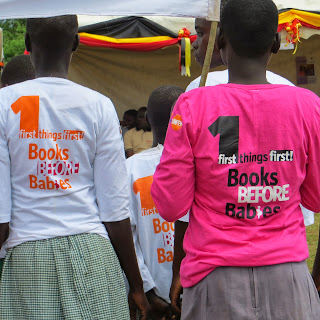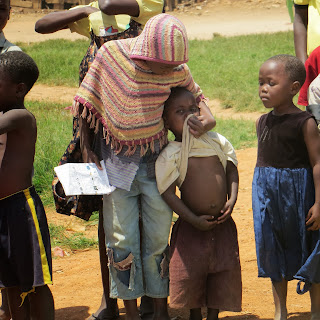Suzan Adong massages the black rusty
arm of her chair, leans back and chats away during the morning with her friends
at the Reproductive Health Unit (RHU), a health-cum-training centre in Apac
district.
Three minutes later, she’s back to business,
making a pillow case on her sewing machine. Five minutes later, a nurse shouts out,
disturbing her concentration.
“Adong, come and get the medicines to
give to your baby,” she says in Langi, the local language spoken by the
region’s inhabitants.
This instruction, its plain message
aside, serves to remind her that she is no longer the ordinary school-going
child she once was. The thought that she’s now a teenage mom trying to continue
her education at an alternative school reoccupies her mind. Adong enrolled for
a six months course in Tailoring and Design in August this year, having dropped
out of school two years earlier because of getting pregnant. Apart from
Tailoring, the centre also offers reproductive health and literacy skills and
gives counseling, mostly to the youth.
 |
| Adong at the RHU clinic which has incorporated a tailoring school for teenage-mother school dropouts. |
Outside Adong’s study room, happy
little faces of children running around the school premises rush past us. Such
moments make her realize what an appalling mistake she made engaging in sex at
the age of 16.
Life changed for the now 19 year old,
who once harbored the ambitions of becoming a nurse, when she exchanged her
body for promised school fees money.
“While I was in Primary seven at
Arocha primary school, I was occasionally sent back home for uncompleted
payments of school fees. However, there was this man who promised to pay Shs
15,000 for me each term if I slept with him. I gave in,” the smooth skinned,
milky eyed lass says, catching her breath as if her heart was about to spring
out of her chest.
This man and Adoch were just village
friends but on the day he proposed to pay her school fees, he held her hand and
they headed to his home. And as they say, the rest is history.
The banner of myths was still flying
high in her young mind. Her colleagues always joked that girls cannot get
pregnant the first time they have sex or that they couldn’t get pregnant if
they had a bath immediately afterwards.
Oblivious of what her parents’
reaction would be, she kept the ‘promise’ and events of the evening a secret.
Two months later, she felt that something
was going on inside her. She had skipped her monthly periods and was starting
to feel sick. Gradually, the five kilometre journey to school from Baradong
village became a cumbersome task.
Later, her mother’s suspicion of her
first born child being pregnant was confirmed after Adoch felt weak and sick,
and upon checking her, the doctor declared that she was pregnant.
“I was chased from home and I went to
stay with my aunt and my lover disappeared on learning that I was pregnant. I
stopped going to school and I can’t stop thinking of what I would have become
if I had struggled on without giving in to this lie!” she coyly says, staring
at the dusty cement floor.
Adoch’s advice now is for schools and
parents to teach the children the dangers of early sexual activity which she
didn’t know much about then.
COST
ON EDUCATION
The 2012 State of Uganda Population report reveals that parenthood
is a leading cause of school dropout among teenage girls. It notes that 30 per cent
of teenage girls cite pregnancy or parenthood as a reason for dropping out of
high school.
Moreover, less than one per cent of young teen
mothers (those who have a baby before 18) attain a university degree by 30 and
this trend negatively impacts on their children’s education.
“Children
of teen mothers are more likely to drop out of high school than those of
mothers who give birth at a later age. In fact, only about two-thirds of
children born to teen mothers earn elementary education compared to 80 per cent
of children of later child bearers,” reads the report.
 |
| A teenage mother in Apac district admires her baby. |
RATIONALE FOR SEX EDUCATION
Lack
of sex education in schools has been identified as a major contributory factor
to the high rate of teenage pregnancy. Joyce Ampumuza, the project officer at DSW
(Deutsche Stiftung Weltbevölkerung), a German NGO, says many young people are
getting misleading information from their peers because parents consider
discussion about sex a taboo.
A
2008 research by the Guttmacher Institute on youths aged 12 to 14 years in
Uganda shows that only 33.8 per cent of females and 22 per cent of males have
received sexuality education in schools. Guttmacher is an American organisation
that seeks to advance sexual and reproductive health through research, policy
analysis and public education. Currently, the ministry of Education messages to
pupils and students is largely focusing on abstinence.
Ampumuza says life skills such as
communications and coping skills and sexual reproductive health rights need to
be incorporated in schools to help reduce the children’s ignorance. This
includes teaching children about the emotional aspects of sexual relationships,
sexually transmitted infections, HIV/Aids and the consequences of becoming
sexually active.
She
adds that this should be done to dispel myths like those Adong had.
Her
views are supported by the United Nations Population Fund (UNFPA) country representative,
Esperance Fundira who believes that information empowers young people with
informative decision making choices.
“When girls are educated and healthy, they
are more likely to marry later, delay childbearing and gain productive or
employable skills. We must therefore enforce existing laws and policies to
ensure that no girl below 18 is allowed to get married,” Fundira argues.
One success story is that of Atar primary school
in Apac that has a project dubbed ‘family initiative’ where teachers and
parents organize monthly counseling sessions for the pupils.
Francis Lagmuht, a teacher at the school,
says the initiative has registered success this year as no dropouts due to
early pregnancy have been recorded compared to four cases last year.
 |
| Girls clad in T-shirts with messages that are aimed at encouraging them to keep in school. |
Elsewhere,
the Netherlands, where sex education begins at preschool and is integrated into
all levels and subjects of schooling, boasts of having one of the lowest teen
birth rates in the world at 5.3 per 1,000 women aged 15 to 19 (2011 UNAIDS
report).
DOUBLE
MINISTRY EFFORT
The ministry of Health has partnered
with the ministry of Education to draft a policy on school health with a
special focus on re-enrolling adolescent ‘mother’ dropouts back into school.
“We intend to work with the Education Ministry
to ensure that we identify girls who have dropped out of school because of
early pregnancy to re-enrol so that they are empowered with knowledge and life
skills,” the acting head for
Reproductive Health Services, in the ministry of Health, Dr
Collins Tusingwiire says.
In the ongoing efforts between the two
ministries, the state minister for Primary Health Care, Sarah Opendi, says
there is a review of the lower school curriculum to incorporate adolescent-friendly
health information in schools.
There
is also support of parent peer programmes for adolescent and reproductive
health and training of peer educators to provide this information in schools.
+being+led+to+the+theatre+for+repair.JPG)





